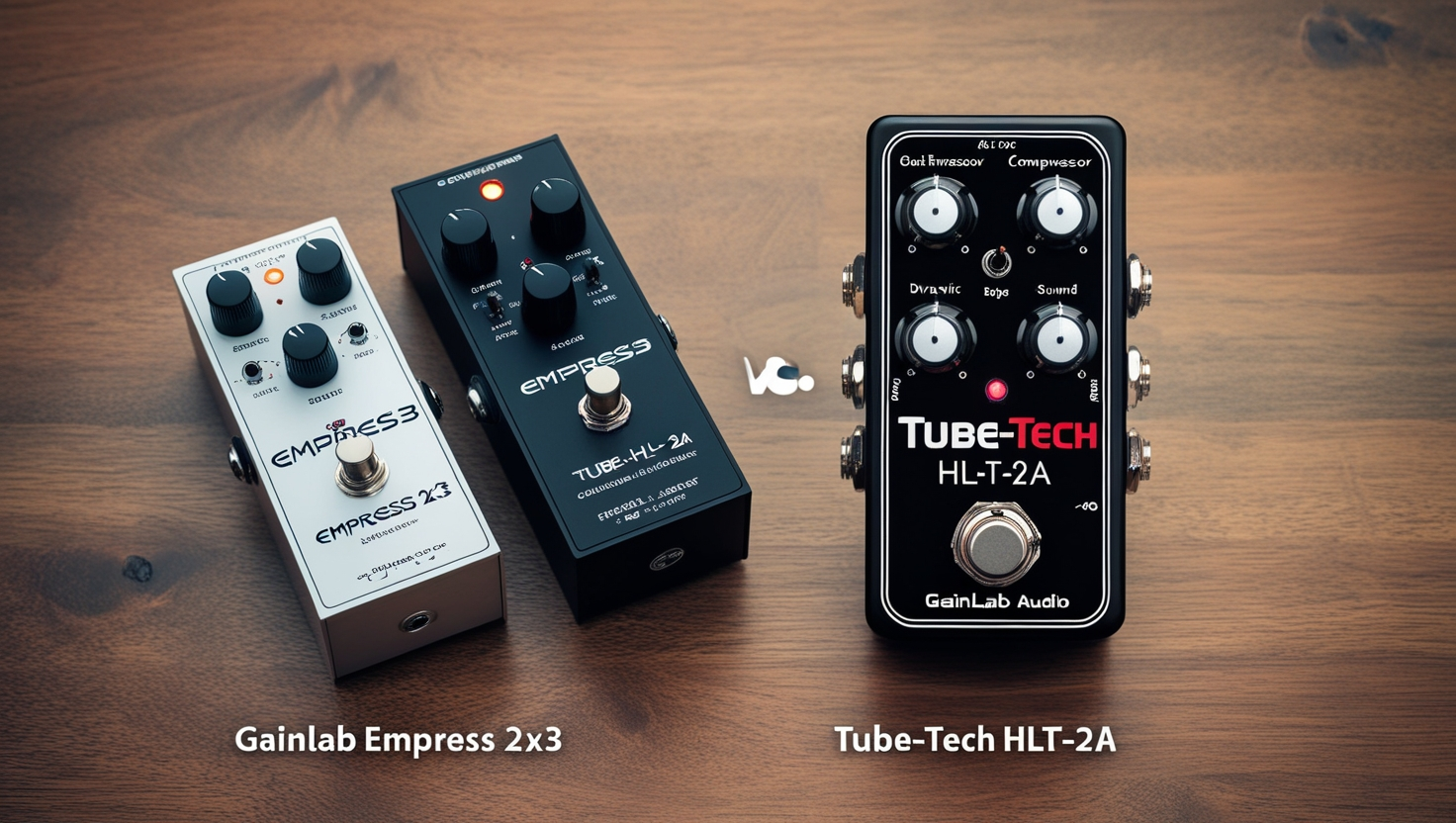Introduction
The Gainlab Audio Empress 2×3 versus Tube-Tech HLT-2A are two highly regarded and integrated processors commonly used in today’s professional production and recording industry. Although both devices are supposed to provide sound at the highest level and improve it in one way or another, they are oriented toward different aspects of audio signal processing. This article will dive into a detailed comparison of the Gainlab Audio Empress 2×3 versus the Tube-Tech HLT-2A, exploring the functionality, features, sound characteristics, and overall user experience each device offers.
This article will explain the capabilities of two devices: the Gainlab Audio Empress 2×3 versus Tube-Tech HLT-2A.
To understand its function, it is ideal to know about its counterpart. The Gainlab Audio Empress 2×3 versus Tube-Tech HLT-2A are audio processing units used in different stages of the recording and mixing process. The Gainlab Audio Empress 2×3 is a modern compressor/limiter, while the Tube-Tech HLT-2A combines EQ and compressor capabilities. Although both have high-quality analog circuits, their operational concepts and uses differ.
Versatile, dynamic control makes the Gainlab Audio Empress 2×3 versus Tube-Tech HLT-2A an excellent, versatile harmonizer, especially in combination and precision. It provides a more sophisticated compression tool, making the app ideal for all forms of music and recording. At the opposite end of the spectrum, the Tube-Tech HLT-2A is known for its tube compression and is often used to add warmth and define the characteristics of the sound that runs through it. This leads to developing another highly proprietary reverb pattern that is in vogue in professional studios.
Design and build quality
When comparing the Gainlab Audio Empress 2×3 versus Tube-Tech HLT-2A, it’s important to consider each unit’s design and build quality. These two manufacturers are known for producing products with great attention to detail, resulting in long-lasting, quality equipment.
The Gainlab Audio Empress 2×3 versus Tube-Tech HLT-2A is housed in a solid, metal, contoured, two-piece enclosure for high-shelf mounting. The unit’s construction has a top-notch appearance and an attractive modern design, which is complemented by user-friendly touch control panels. The unit has a large front panel with clear gauges and rotary controls so that users can effectively control the compression ratio and other functions without the influence of a third party. The construction is hefty and strong, providing durability for professional studio use.
The same goes for the Tube-Tech HLT-2A, which has a vintage and rugged design and a strictly analog control panel. The unit is designed to withstand extended use in a professional studio environment. That’s why the Tube-Tech HLT-2A control is ergonomic: it has knobs and switches for easy adjustment of EQ and other compressor parameters. The concept of the unit aims to make the product more end-user friendly while maintaining the standards that Tube-Tech has established in the market.
Functionality and features
The Gainlab Audio Empress 2×3 versus Tube-Tech HLT-2A comparison really shines when you consider the functionality and features of each device. Each provides invaluable functionality in the studio but focuses on different audio manipulation actions.
Gainlab does an impressive job of handling dynamic capabilities. Empress 2×3 is a pretty good equalizer. Its functions as a compressor and limiter provide the most detailed control of the dynamics of the sound source. One of its unique attributes is multi-band compression, which makes achieving good sound even better. The Gainlab Audio Empress 2×3 also provides fast and clean compression that doesn’t even color the sound. This is well suited where it is desirable to preserve the identity of the sound as much as possible.
On the other hand, the Tube-Tech HLT-2A is a high-pass filter companding device, making it closer to a dedicated tone shaper. Users will find a feature combining equalization and compression for color and audio compression in one device. The HLT-2A uses tubes And also gives that usual, warm tube sound that most producers attempt to use to heat their recordings. Additionally, frequency-selective compression and the finely tuned management of the HLT-2A’s tube era make it applicable across standard audio categories.
Sound characteristics
Regarding the sound, the Gainlab Audio Empress 2×3 versus Tube-Tech HLT-2A debate revolves around the unique tonal timbre each unit imparts to the sound. Criticizing the Empress 2×3 as a Gainlab Audio product, this little device is known for its natural sound. It is perfect regarding source material transparency, making it suitable for applications where it is desirable to have fine control over dynamic range without the distortion inherent in future sources. The fact that the Gainlab Audio Empress 2×3 does not add coloration to the sound is essential when working with sensitive audio sources or looking for a compelling dynamic processing tool.
By comparison, the Tube-Tech HLT-2A delivers a very different kind of tone. Thanks to the tube design, it brings back harmonic richness that can, in turn, enhance the tone of instruments and vocals. The control range in this compressor is limited, and much of it is related to the music, making it ideal for warm music genres. Engineers use it to make digital recordings sound more vintage or analog, which they prefer.
Versatility and application
The Gainlab Audio Empress 2×3 versus Tube-Tech HLT-2A units are flexible, healthy, extraordinary packages. The Empress 2×3 is more applicable for responsibilities requiring much less work and unique dynamic manipulation. This is right for various compressions that do not have a noticeable effect on a particular signal, such as at some point of studying or on the mixed bus. It also comes in reachable whilst composing complicated tracks in which joyous bands may require dynamic manipulation independently because the Gainlab Audio Empress 2×3 controls more than one band.
At the same time, the Tube-Tech HLT-2A aims to make the sound richer in character and tonal range. Engineers tend to reach for this unit for both EQ and compression when tone shaping is critical. Used to add color to vocals or control the bottom end of a kick drum, the Tube-Tech HLT-2A excels in adding some timbre to a piece of sound. Crimsons are preferred in jazz, rock, and electronic music, as most crave warm and vintage flavors.
Conclusion: Gainlab Audio Empress 2×3 Versus Tube-Tech HLT-2A
In the Gainlab Audio Empress 2×3 versus Tube-Tech HLT-2A debate, the decision ultimately comes down to the specific needs of the user and the sound they want to achieve. First, if dynamic control and transparency are desired, the Gainlab Audio Empress 2×3 can be considered a winner. Sophisticated dynamic range processing makes it an essential tool to help engineers work with transparency and/>
However, if you want warmth, color, and a specific tonal character, the Tube-Tech HLT-2A can be highlighted. With midi controller support and several VSTs, it’s best suited to give your sound that vintage feel with tube excitation and hybrid EQ and compression features.
Both units are exceptional in their own right, and the Gainlab Audio Empress 2×3 versus Tube-Tech HLT-2A comparison ultimately comes down to whether you prefer pristine, transparent compression or the warmth and character offered by tube-based processing. Pros: For engineers and producers, having both units in the studio could complete their palette of sound-shaping tools, so it’s the best of both worlds.



